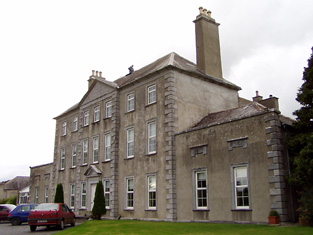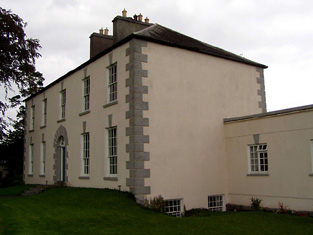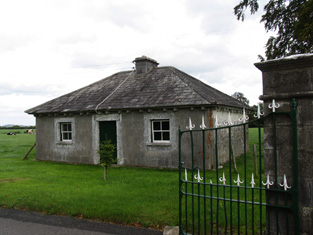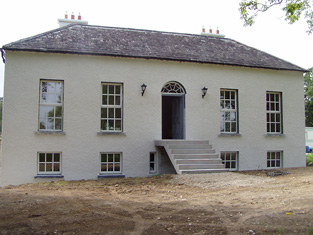Clermont House
Houses within 5km of this house
Displaying 26 houses.
Houses within 5km of Clermont House
Displaying 26 houses.
| House name | Description | |
|---|---|---|
| Bantis | In 1814 Mr Kennedy is recorded as the proprietor of Bantis and Lewis mentions the extensive brewery of Edward Kennedy at Bantis in 1837. The Ordnance Survey Name Books record Bantis as "a neat dwelling house", the residence of Edward Kennedy. Buildings valued at £31+ and 526 acres at Bantis were held from the Honourable O.F.G. Toler by Edward, James, Denis, John and Patrick Kennedy and Henry Fitzgerald at the time of Griffith's Valuation. A house is still extant at the site. | |
| Hermitage | This house was occupied by J.A. [John Andrew] Jackson at the time of Griffith's Valuation and held from his father Major Jackson. The house was valued at £20.16 shillings and was located close to the River Ollatrim. This house was renovated in the early 21st century. |

|
| Mount Pleasant | The main home of the Jackson family in the 19th century, occupied by John Short in 1814, by Captain Jackson in the 1830s and by Major Jackson in the early 1850s. The house with 448 acres was held from John Willington. The buildings were valued at £29+. Francis Freeman was the tenant in 1870. This house no longer exists. | |
| Castle Willington | Castle Willington was the seat of a junior branch of the Willington family of Killoskehane Castle. In 1786 Wilson refers to it as the seat of Mr. Willington. The Ordnance Survey Name Books note it as the seat of James Willington. Valued at £38+ it was held by James Willington in fee at the time of Griffith's Valuation. Alice C. Langford occupied this house valued at £20 in 1906. She was a daughter of John Willington and had married in 1877 Charles C. Coplen Langford. This house of 3 storys with tower house attached is still a residence. |

|
| Rapla | Rapla was a Freeman home in the 18th century and was inhabited for a time by the Otways, Phoebe Otway having married Daniel Freeman of Rapla. Wilson, writing in 1786, refers to Rapla as the seat of Mr. Willington. Jonathan Willington, younger brother of John of Killoskehane, was residing at Rapla in 1814 and William Cooper Crawford in 1837. William Cooper Crawford married Sophia Morgan [nee Willington] as her second husband. By the early 1850s John Tuthill was resident holding the house valued at £42+ from William Cooper Crawford. The sale rental of 1850 describes Rapla as a first class house held on a lease for 7 years from the Court of Chancery to John Tuthill. This house no longer exists. |

|
| Donnybrook | This house was the seat of a branch of the Poe family in the 18th and 19th centuries. William Poe was resident in 1814 and Lewis records him as the proprietor but the house was occupied by a tenant. The Ordnance Survey Name Books mention William Jackson as the occupier and describe the house as "large and commodious". At the time of Griffith's Valuation William Poe held the property in fee, the buildings were valued at £16.14 shillings. Donnybrook is still extant. |

|
| Wilton | This house located close to Donnybrook was vacant at the time of Griffith's Valuation and held by William Poe. It was valued at £10+. Earlier, in 1839, the Ordnance Survey Name books had noted it as the residence of John Poe but "out of repair at present". It no longer exists. | |
| Southhill | In 1840 the Ordnance Survey Name Books refer to South Hill House as "a good dwelling house, the residence of Mr. J. Manders" though Patrick Clark is mentioned as the proprietor. It was valued at £23+ in the mid 19th century, occupied by John Vincent and held from the Honourable O.F.G.Toler. At the time of the 1855 sale the house was untenanted. This house no longer exists. | |
| Ashleypark | Ashleypark was occupied by the Heads from at least the 1770s. It was the home of John Head in 1814. It became the seat of a branch of the Atkinson family when purchased by George Guy Atkinson in 1824. G. Atkinson was the proprietor in 1837. George Atkinson held the property in fee at the time of Griffith's Valuation when the buildings were valued at £23.10 shillings. Thomas Biggs of the Bellevue family married Alice Margery Atkinson in 1903. The house was valued at £35 and occupied by Thomas B. Biggs Atkinson in 1906. His niece Zelie Biggs eventually inherited Ashleypark. The house was sold to Sean and Nora Mounsey in 1983. It now functions as a guest house. |

|
| Ballyrickard House | Ballyrickard may possibly be the house known as Lettyville on the Taylor and Skinner map from the 1770s. Leet records Daniel Falkener as resident at Ballyrickard in 1814 and Lewis records N. Falkiner as the proprietor. The Ordnance Survey Name Books refer to Ballyrickard as "a commodious house", the residence of Nathaniel Falkiner. In the early 1850s Addison Hone was the occupier holding the property from Richard H. Falkiner. The buildings were valued at £15. This 18th century house is still extant and occupied. |

|
| Congor | Occupied by F. Falkiner in 1837 and described by the Ordnance Survey Name Books as "the commodious residence of Nicholas Biddulph" in 1840. It was still occupied by him at the time of Griffith's Valuation when the house was valued at £20. Nicholas Biddulph was still resident in the mid 1870s when he is recorded as owning 74 acres in county Tipperary. A building is still located at this site. | |
| Beechwood Park | Beechwood, near Nenagh, was occupied by Richard C. Langford in 1814 and Lewis writes that Beechwood was the property of Colonel Toler Osborne but was occupied by D. Falkiner and had once been the residence of the Earl of Norbury. Wilson, writing in 1786, refers to "Beech Wood, the fine seat of Daniel Toler". In the mid 19th century William Osborne was resident, holding the property in fee. The buildings were valued at £33. Occupied by Lady Osborne in 1906 when the buildings were valued at £40+. The home of Philip Blake, genealogist, in the mid 20th century. This mid 18th century house still functions as a country house. |

|
| Ballinwear | In 1840 the Ordnance Survey Name Books describe Ballinwear as "a good dwelling house...surrounded with plantation and ornamental ground". James Otway is recorded as the occupier of Ballinwear at the time of Griffith's Valuation. At this time the house was valued at £14 and held from the Earl of Norbury. Toler Kingsley Wolfe was the house occupant in 1867. The Ballinwear property had been leased to Caesar George Otway by the Honourable Otway Fortescue Toler in 1859. The house was later altered and a building is still in existence at the site. | |
| Willow Lodge | James Fleetwood was resident at Willow Lodge in 1814 and in 1837. By the time of Griffith's Valuation the house appears to be only valued at £1 and occupied by David Tierney. Willow Lodge is marked on the first edition Ordnance Survey map. It is named Alma on the 25-inch map of the 1890s. There is still an extant house at the site. | |
| Tenessee | This house is labelled Tenessee House on both the First and 25-inch edition Ordnance Survey map. In 1841 the Ordnance Survey Name Books suggest that it was the property of Lord Dunally. In the mid 19th century it was occupied by Thomas R. Barnes and held from Joseph Falkiner. The buildings were valued at £14. 15 shillings. The house is still in use as a residence. |

|
| Coolnamunna | At the time of Griffith's Valuation Edward Kennedy held buildings valued at £34+ from Ellen Lloyd [widow of Henry Jesse Lloyd of Castle Iney?] in the townland of Coolnamunna. He had a distillery in Mullenkeagh valued at £47. Edward Kennedy of Coolnamoner Park owned 432 acres in county Tipperary in the 1870s. |

|
| Glenahilty | William Kennedy was occupying Glenahilty from at least 1837 when Lewis records him as resident althought the property belonged to J.C. Fitzgerald. The house was valued at £6.10 shillings at the time of Griffith's Valuation and was held with 189 acres of land and 210 acres of bog from Fitzgerald. | |
| Fort William | A Parker residence in the early part of the 19th century. In 1841 the Ordnance Survey Name Books referred to it as "a splendid demesne and fine mansion house, the residence of Mr. Parker". By the time of Griffith's Valuation Fort William was occupied by Miss Crawford who held the property from Messrs Egan. The buildings were valued at £18.15 shillings. The Egan sale rental of 1854 gives details of the original lease which was from Charles Egan to John Greene in 1769 for three lives renewable for ever. The last renewal was dated 1803 from John Egan to William Crawford. This house is still in use. |

|
| Modreeny House | In 1786 Wilson refers to "Moderenny" as the seat of Sir Amyrald Dancer. The Ordnance Survey Name Books refer to the house as Eminisky House in 1841 but it is marked on the first edition map as Modreeny House and was the home of the Dancer family. It was replaced by a new house circa 1920s. The outbuildings, gates and gatelodge of the original house still remain. At the time of Griffith's Valuation Sir Thomas B. Dancer held this property in fee. The buildings were valued at £21. Hussey gives Modreeny House as the address of Sir Thomas Dancer in 1878. |

|
| Hilton | Hilton, located just to the south of Modreeny House, was the home of Thomas Dancer, later 6th Baronet, in 1837 and of the 6th Baronet's son, Thomas J. Dancer, in the mid 19th century. Thomas J. Dancer held the house valued at £15 from his father Sir Thomas B. Dancer, 6th Baronet. In 1841 the Ordnance Survey Name Books had noted the house as the residence of Thomas Stoney. A house is still located at this site. | |
| Elysium | This house is marked on the first edition Ordnance Survey map and was inhabited by Thomas Ely in 1837. Thomas Ely held the property in fee at the time of Griffith's Valuation when the house was valued at £23. The Elys were still resident in the 1870s. George Evans was occupying this house in 1906. There is still a house located at this site. | |
| Mertonhall | Merton, Cloghjordan, was the home of T.G. Fitzgibbon in 1814. It was purchased by Robert Hall in 1828 and he was the proprietor in 1837. The Ordnance Survey Name Books noted in 1841 that it was formerly known as "Litty Ville House". The house was valued at £55 at the time of Griffith's Valuation and held by Robert Hall in fee. The Hall family continued to use Merton as a residence in the 1870s. By 1906 the representatives of De Courcy P. Ireland were occupying Mertonhall. He was married to Ada Hall. This house is now demolished. | |
| Lisheen (Lower Ormond) | In 1840 the Ordnance Survey Name Books refer to Lisheen House in the parish of Aglishcloghane as held by John Crawford but an addendum to the entry on the parish of Uskane note that Lisheen was the residence of Geo.Fosbery, Jnr. By the time of Griffith's Valuation it was held in fee by George Fosberry and valued at almost £8. A house is still extant at the site. | |
| Kilruane House | A house constructed in the later nineteenth century on lands owned by Sir Mark A.H. Tuite. It is labelled Kilruane House on the 25-inch Ordnance Survey map of the 1890s. In 1894 Slater notes it as the residence of Sir Mark Tuite. It is still extant and occupied. |

|
| Elm Hill House | The Ordnance Survey Name Books record William Middleton as the occupier of Elm Hill House in 1839 and mention the surroundings as "a very pretty demesne situated in a beautiful locality". At the time of Griffith's Valuation, William Middleton was leasing this property from the Poe estate when the house was valued at almost £8. The original house is no longer extant and a modern house has been constructed at the site. | |
| River Lawn | In 1839, he Ordnance Survey Name Books describe River Lawn house as "a commodious house, the property of William Poe, in the occupation of E. Radford esq". At the time of Griffith's Valuation, when it was valued at almost £10 it was leased by Augustus H. Going from William Poe. It is still extant and occupied. |

|

